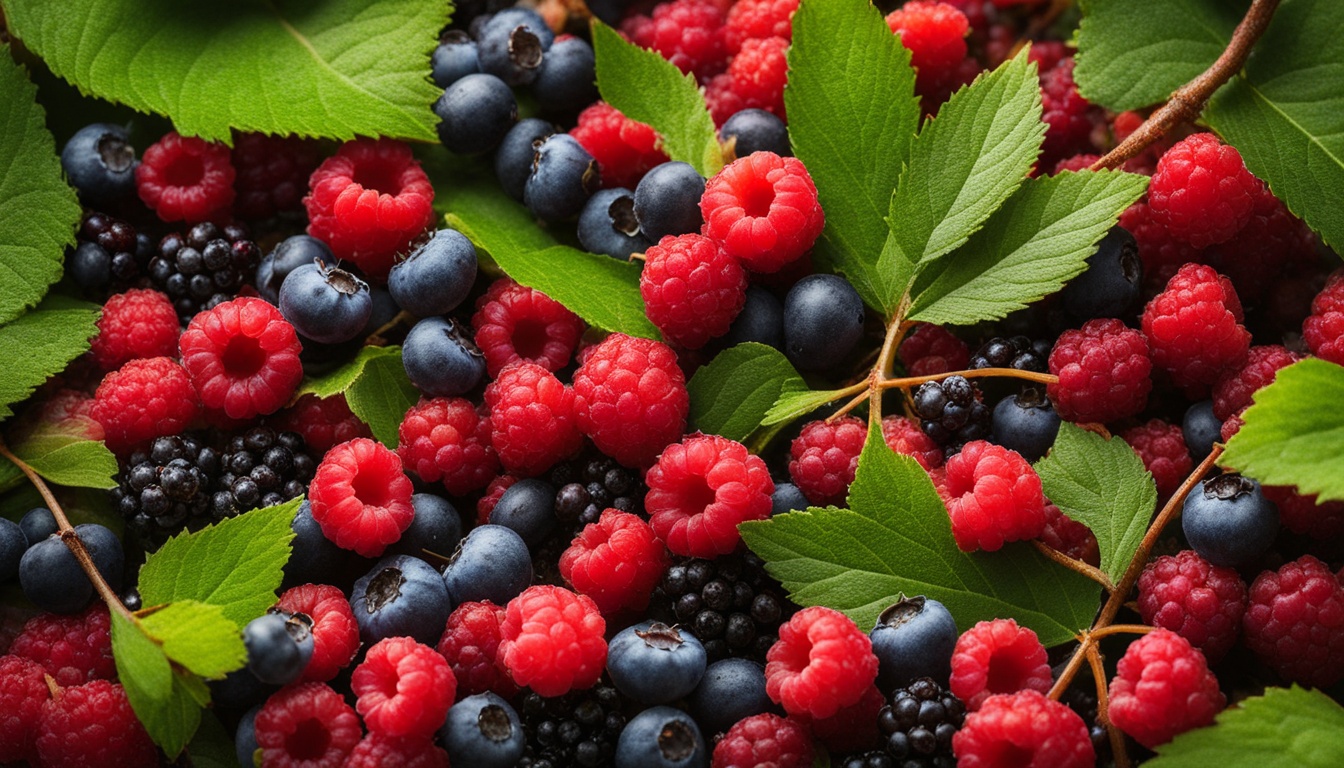Foraging in the USA for wild berries can be very rewarding. You can find familiar types like strawberries, blueberries, and raspberries. However, many wild berries are unsafe to eat and can be dangerous or deadly. This country has a wide variety of wild berries that range in taste from sour to sweet. Enjoying foraging is wonderful, but it’s important to know the difference. Stay safe by learning which are safe to pick and eat.
Knowing which wild berries are safe to eat in the USA is key. When you learn to spot them, you can enjoy picking without worry. Use your knowledge and be careful. This makes your foraging experience both safe and fun.
Understanding Wild Berries: Safety and Identification
Knowing which wild berries are safe to eat is key. It’s good to learn about their benefits and how to spot them. Wild berries are great for your health. They boost your immune system with vitamin C and help your heart with antioxidants.
Benefits of Eating Wild Berries
Safe wild berries are healthy. Elderberries, for instance, help your immune system. They have lots of vitamins to fight off sickness. Huckleberries are also good. They have compounds that are good for your heart and might help fight cancer. Picking these berries is like a treasure hunt for your health.
Key Tips for Identifying Safe Wild Berries
To spot safe wild berries, look for known colors like red and blue. The shape of the berries and how they grow can also be a clue. Berries in safe-looking groups or with unique features are often edible. But, always be careful. If you’re not sure, get advice from experts. This approach helps you enjoy the benefits risk-free.
Here’s a close look at elderberries and huckleberries:
| Berry Type | Nutritional Benefits | Identification Tips |
|---|---|---|
| Elderberries | Boosts immune system, rich in vitamin C and B6 | Dark purple-black color, small clusters |
| Huckleberries | High in anthocyanins and polyphenols | Red, blue, or black, similar in appearance to blueberries, found in the Northwestern America |
Blueberries: A Common and Safe Choice
Exploring the wild areas of the USA often leads foragers to pick blueberries. These berries are tasty, mixing sweet and tart. They are also packed with nutrients.
Where to Find Wild Blueberries
Blueberries grow in specific places in the country. You can look for them in forests and mountains between May and October. The US wild berry picking guide suggests finding small clusters of blue or purple berries to know they’re ready to pick.
Health Benefits of Blueberries
Blueberries offer many health benefits. They’re full of antioxidants and vitamin C. These help your heart and support your immune system. Eating blueberries regularly boosts your health.
| Criteria | Details |
|---|---|
| Color | Blue or Purple |
| Availability | May through October |
| Nutrition | High in antioxidants and vitamin C |
| Benefits | Promotes heart health, supports immune system |
The Versatile Blackberries
Blackberries are among the top wild berries to eat. They are everywhere in the USA. Their dark color stands out. They bring lots of ways to enjoy food to your table.
If you love them fresh or in tasty recipes, blackberries are for you. They are full of fiber and key vitamins. This makes them a smart choice for staying healthy.
Adding blackberries to your foraging list is wise. They taste great and fit into many dishes. They also bump up your nutrition levels.
- Fresh snacking
- Homemade jams
- Baking pies and desserts
Choosing blackberries means picking health and flavor. They are loaded with vitamins and fiber. No wonder they’re a top choice in the wild berry world.
Huckleberries: Worth the Hike
The wild natural lands of Northwestern America and Western Canada hold a tasty secret – wild huckleberries. These berries look similar to blueberries and grow in the mountains and forests. They’re a treat for anyone who loves exploring and foraging.
Identifying Huckleberries
Finding huckleberries means looking for shades of red, blue, or black on low shrubs. They can be mistaken for blueberries, but they’re a little different. Huckleberries are smaller and have a unique taste. Always be sure you know it’s a huckleberry before you eat it.
Nutritional Value of Huckleberries
These berries are more than just tasty. Huckleberries are rich in antioxidants, which fight inflammation and heart disease. They’re a great addition to your diet, offering health benefits along with their delicious flavor.
“Huckleberries are known for containing more beneficial compounds than many other fruits, making them a true superfood.”
Knowing about huckleberries’ nutrition and how to find them can make your outdoor trips more interesting. Adding these berries to your diet will not only please your taste buds. They are also packed with nutrients that are good for your health.
Overview of Edible Wild Berries in the USA
The United States is full of wild berries you can safely eat. These berries taste great and have health benefits too. Learning what makes a berry safe can make picking them enjoyable and safe.
Common Characteristics of Safe Wild Berries
Safe wild berries in the USA have key things in common. They are sweet or tart and look like small clusters or rounds. These berries range in color from orange and red to black and blue. By knowing these features, you can tell which ones are good to eat.
| Edible Wild Berry | Color | Flavor |
|---|---|---|
| Mulberries | Red, Black | Sweet |
| Gooseberries | Green, Red | Tart |
| Blackberries | Dark Purple | Sweet |
| Blueberries | Blue, Purple | Sweet, Tart |
Getting to know these berries helps you pick them safely and enjoy nature. This overview of edible wild berries is a great start for exploring. Always be sure about a berry before you eat it.
Elderberries: Nutrient-Packed and Tangy
Elderberries are celebrated for their small berries and dark colors. These tangy elderberries stand out, offering a unique flavor. They are filled with vitamins C and B6, which are essential.
But, you need to cook elderberries before eating them. Raw elderberries have some chemicals that could make you feel sick. Cooking removes these chemicals, making them safe and healthy to eat.
| Nutrient | Benefit |
|---|---|
| Vitamin C | Boosts immune system |
| Vitamin B6 | Enhances brain function |
Tangy elderberries are not just tasty; they are also good for you. Remember, cook them first to stay healthy.
Delicious Gooseberries
Gooseberries are tasty and good for you. They are loved worldwide for their many flavors and health perks. You can get them in American and European types, each with their own unique taste.
Types of Gooseberries: American and European
American and European gooseberries are the main kinds. American ones are smaller and tougher against sickness. On the other hand, European gooseberries are bigger and offer more tastes. Both have lots of vitamin C and fiber, which are great for your health.
How to Enjoy Gooseberries
You can enjoy gooseberries in many ways. Eat them fresh or add them to dishes. They’re great for jams, pies, and even in meat sauces.
Their special taste makes any meal better. Plus, they add nutrition and flavor.
Chokeberries: Tart and Vitamin-Rich
Chokeberries are prized for their tart and vitamin-rich profile. They grow in eastern North America. You can spot them by their small, dark-purple to black appearance. These berries taste semisweet with a distinct tartness. This makes them perfect for many dishes.
Their unique taste isn’t their only benefit. They are rich in vitamin K, crucial for bone health. They also rank high in antioxidants, which protect the body against diseases.
Chokeberries are used to make wines, jams, and teas. They fit well in both sweet and savory treats. Thus, they are a top choice for those seeking both flavor and nutrients.
Below you’ll find the nutritional highlights of chokeberries. They are indeed vitamin-rich:
| Nutrient | Amount per 100g |
|---|---|
| Vitamin K | 21.0 µg |
| Antioxidants (ORAC) | 16,062 µmol TE |
| Fiber | 5.3 g |
| Vitamin C | 21 mg |
Adding chokeberries to your meals is a fun way to enjoy their unique taste. And, they bring a host of health perks. From strengthening bones to fighting off diseases, these berries are truly a gift from nature.
The Scarce and Valuable Cloudberries
Cloudberries are a rare treat found in the Northern Hemisphere. They are known for their unique taste and rich nutrients. These golden berries look like raspberries but taste different. They are sweet like red currants with a little tartness.
Finding these berries is like discovering a hidden gem. It’s a rewarding quest for foragers. They remind us of nature’s rich bounty.

Where to Find Cloudberries
Looking for cloudberries? You’ll find them in boggy and mountainous areas up north. Places like Alaska, Canada, and Scandinavia are perfect. These cold-resistant berries love peat-rich wetlands.
Finding cloudberries takes patience and hard work. They grow in remote places. But, the search is worth it for their health-boosting antioxidants.
Unique Taste and Uses
Cloudberries stand out because of their unique sweet and tart flavor. They are great raw or cooked. You can use them to make jams, jellies, and desserts.
Besides being tasty, cloudberries are full of vitamin C. They also have ellagitannins, which may help the immune system and fight cancer.
Mulberries: Sweet and Juicy
Mulberries have a sweet, vibrant taste. They come in colors like white, red, or purple. You can enjoy them as a natural candy that also brings health benefits.
Health Benefits of Mulberries
Mulberries are a superfood because of their nutrients. They are full of vitamins C, B, with magnesium and potassium. These help your immune system and general health.
Studies show they can lower blood sugar, good for diabetics. Their fiber aids digestion and helps with losing weight.
How to Consume Mulberries
Here’s how you can eat mulberries:
- Fresh snacking: Simply wash and enjoy them as a sweet treat.
- In desserts: Add them to pies, tarts, and ice creams for a delightful flavor.
- Breakfast foods: Include them in your morning cereal, yogurt, or smoothie.
- Preserves: Make jams and jellies for a spread that bursts with sweetness.
| Benefits | Details |
|---|---|
| Nutrients | Rich in vitamins C, B, magnesium, and potassium |
| Health Improvements | Supports immune system, digestion, and weight loss |
| Culinary Uses | Fresh snacking, desserts, breakfast foods, and preserves |
Lesser-Known Safe Wild Berries
Many berries are well-known, but others are less common. Some lesser-known wild berries are worth discovering. Examples include salmonberries, saskatoon berries, guelder rose, and barberries. These berries stand out for their unique taste and good-for-you properties. They offer a fun change for those looking to expand their foraging pleasures.
Salmonberries are from the west coast and shine with their sunset color. Their taste is mildly sweet, perfect for eating fresh or in treats. Saskatoon berries, found in the north, are like blueberries but with more antioxidants. This makes them a healthy snack.
Guelder rose berries are bright red and have a tangy kick. They excel in preserves and offer possible health benefits. Barberries, from thorny shrubs, bring a sour punch to dishes. Each of these wild berries offers a different flavor and health boost. They are a great addition for food explorers wanting variety and nutrition.
FAQ
What types of wild berries are safe to eat in the USA?
In the USA, safe wild berries include strawberries, blueberries, raspberries, and more. It is key to know how to pick out the safe ones from the harmful ones.
What are the benefits of eating wild berries?
Wild berries have antioxidants that can help keep your body strong. They have vitamins like C and B, and they taste great, too.
What are some key tips for identifying safe wild berries?
To pick safe wild berries, look for ones that are blue, purple, or black. It’s also smart to ask someone who knows a lot about them to make sure they’re safe to eat.
Where can I find wild blueberries in the USA?
You can find wild blueberries in the forest or mountains. They grow in little groups and are ready to pick from May to October.
What are the health benefits of blueberries?
Blueberries are good for your heart and help your immune system. They also keep your skin healthy and your mind sharp.
Why are blackberries considered versatile wild berries?
Blackberries are easy to find and can be used in many recipes. They’re not only tasty but also give you fiber and vitamins.
How can you identify huckleberries?
Huckleberries look a lot like blueberries. They come in colors like red, blue, or black. They grow in the mountains of America and Canada.
What is the nutritional value of huckleberries?
Huckleberries have a lot of antioxidants. They are also full of vitamins that are good for your heart and overall health.
What are the common characteristics of safe wild berries?
Safe wild berries taste sweet or tart and have familiar shapes. They come in various colors. Knowing these things helps pick the right ones.
Why must elderberries be cooked before consumption?
Elderberries need to be cooked to remove harmful compounds. This way, you can safely get the benefits of their vitamins.
What types of gooseberries are there, and how can they be enjoyed?
There are American and European gooseberries. They’re good both fresh and in desserts, giving you a lot of vitamin C and fiber.
What makes chokeberries unique among wild berries?
Chokeberries have a unique flavor and are used in many things like wines. Native to eastern North America, they are very healthy with lots of antioxidants.
Where can I find cloudberries in the USA?
Cloudberries are rare in the USA but can be found in the north. They look like raspberries but taste different. They are rich in vitamin C and ellagitannins.
What health benefits do mulberries offer?
Mulberries are packed with nutrients and can help control blood sugar. They’re good for managing weight and are tasty in recipes.
What are some lesser-known safe wild berries?
Wild berries like salmonberries, saskatoon berries, and others are out there. They each have their own special taste and good health effects, great for anyone looking for new foods.







